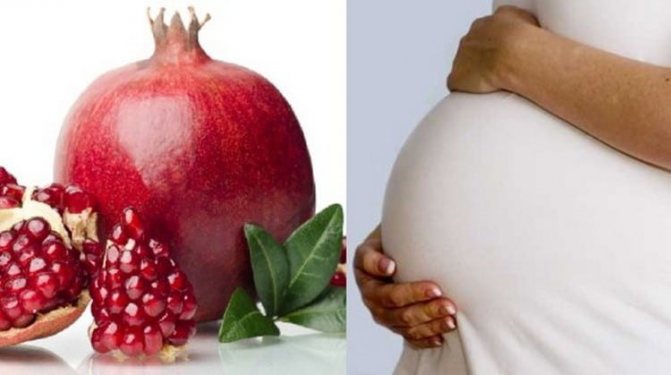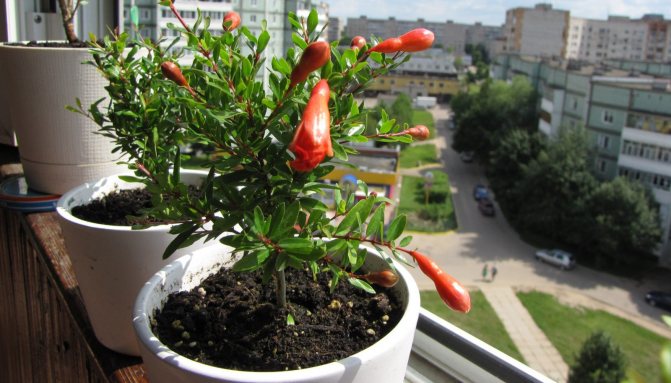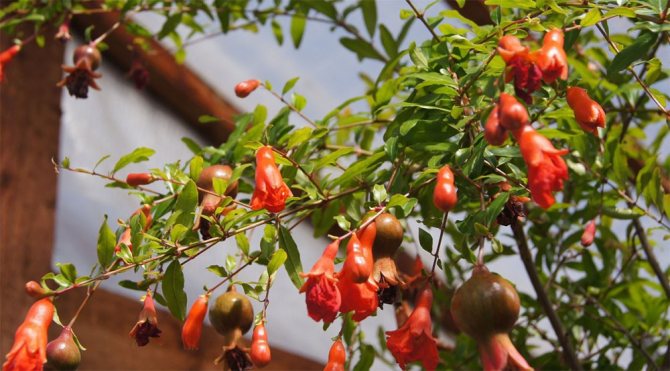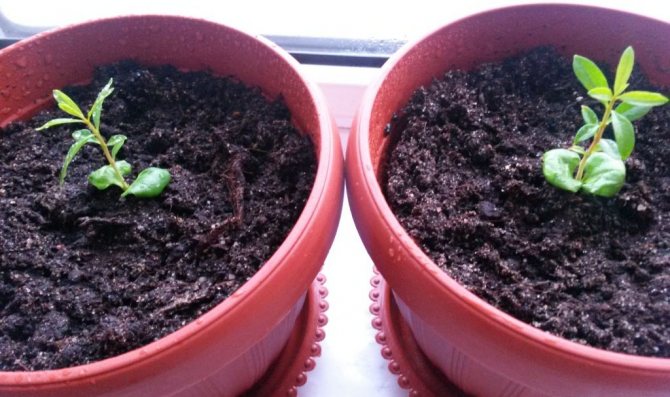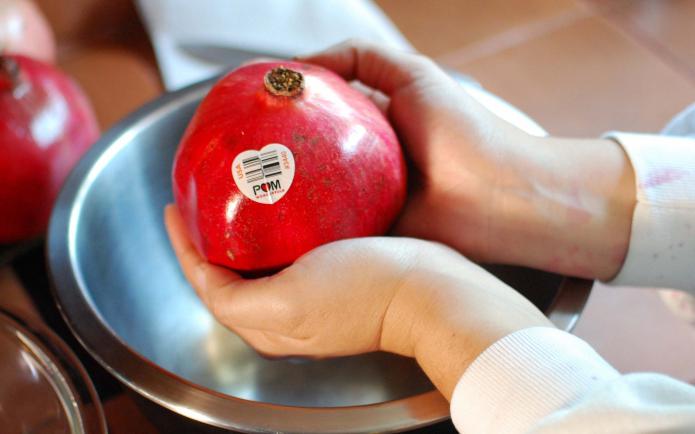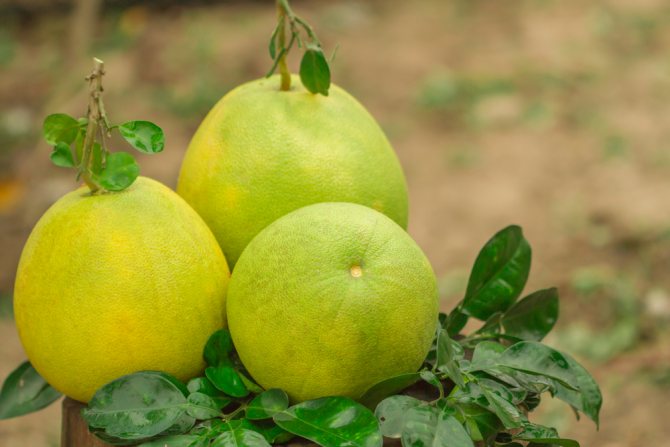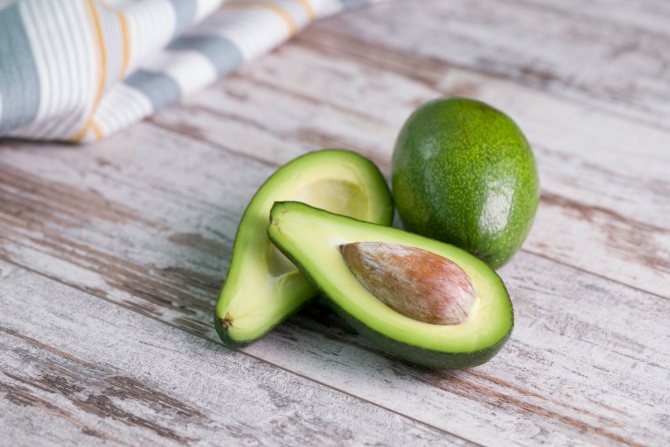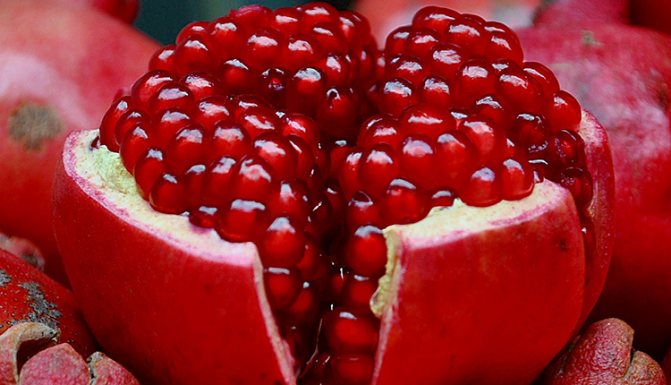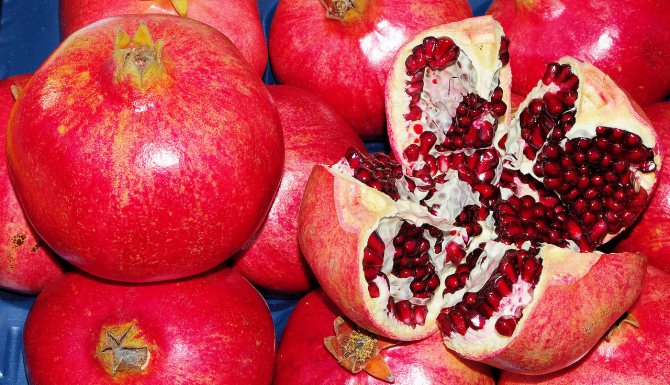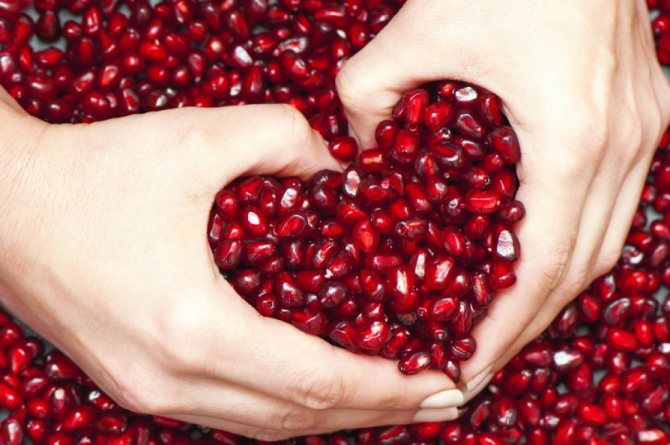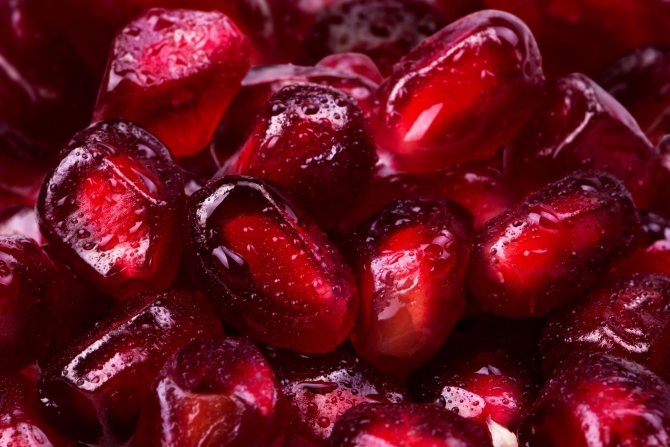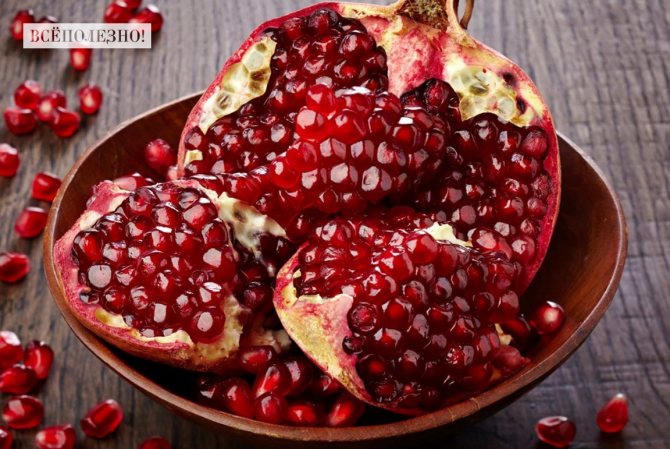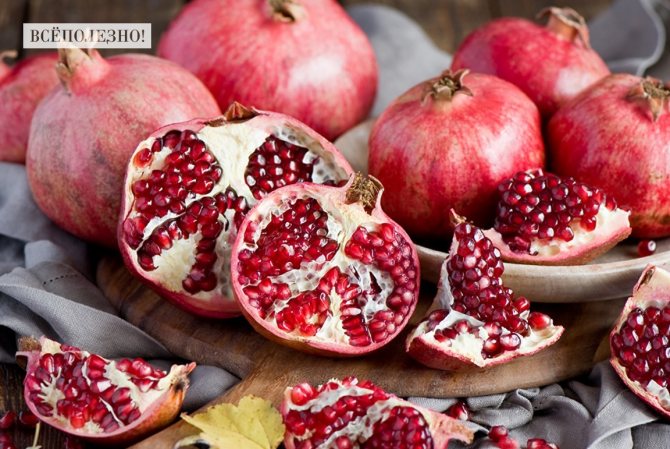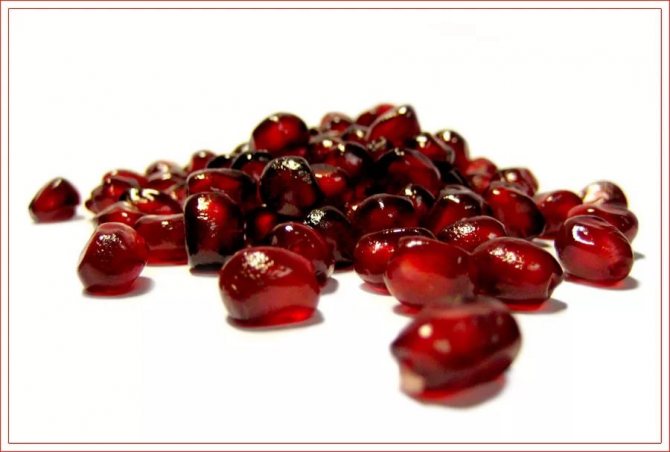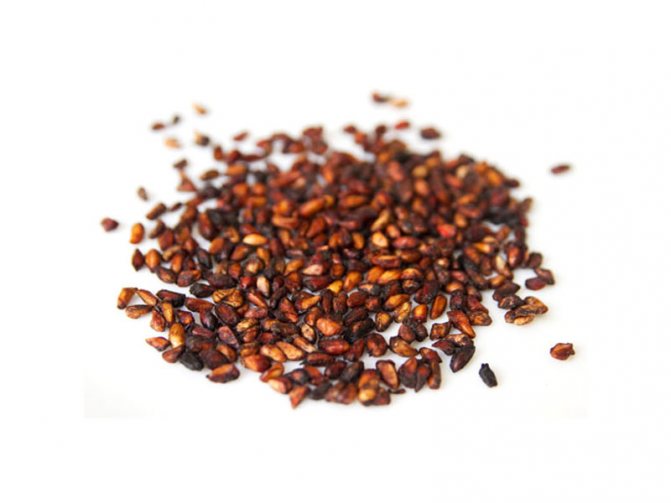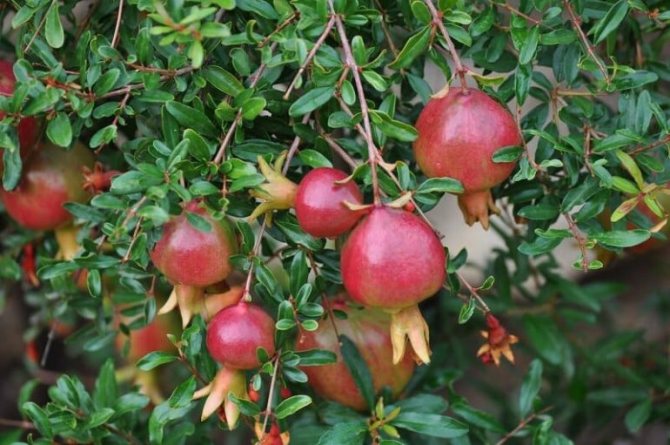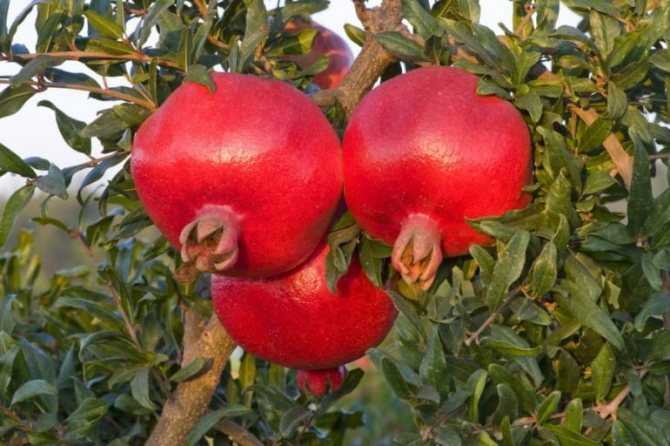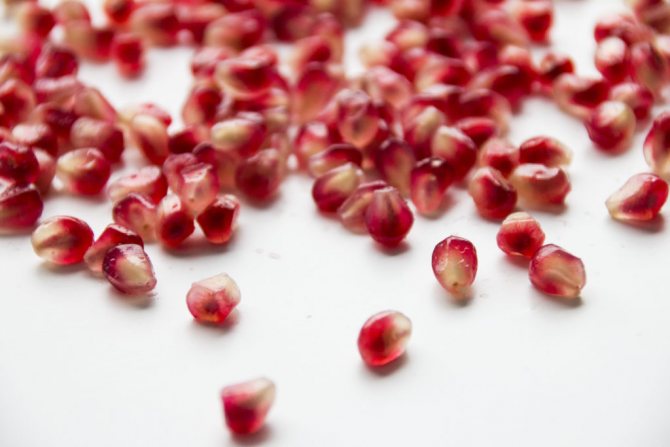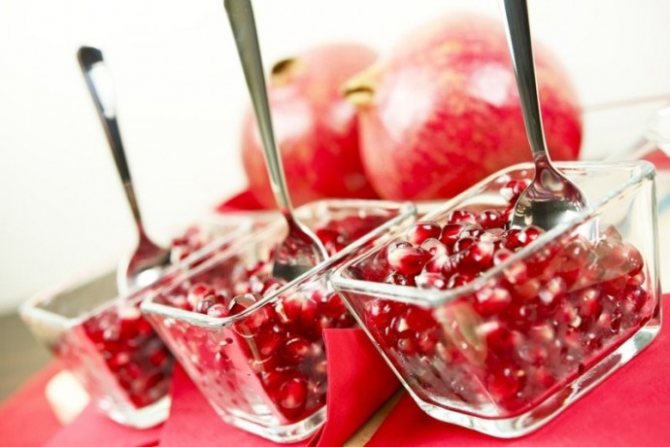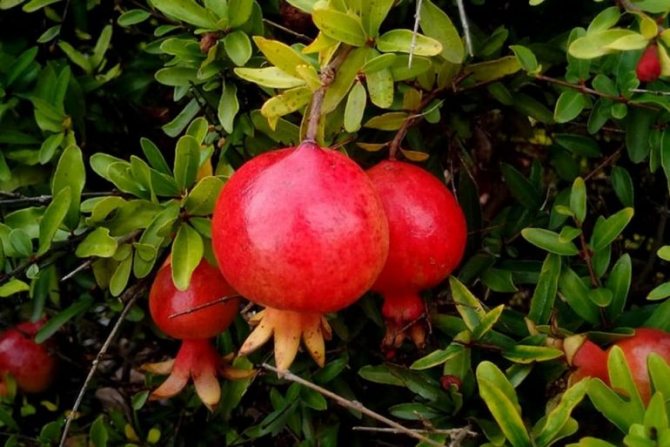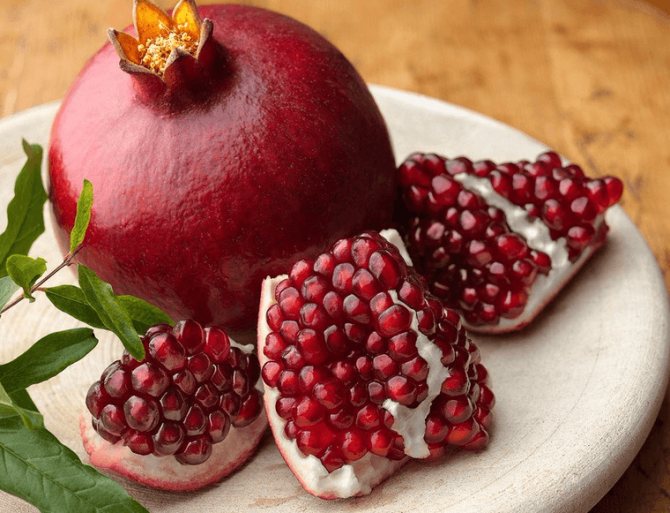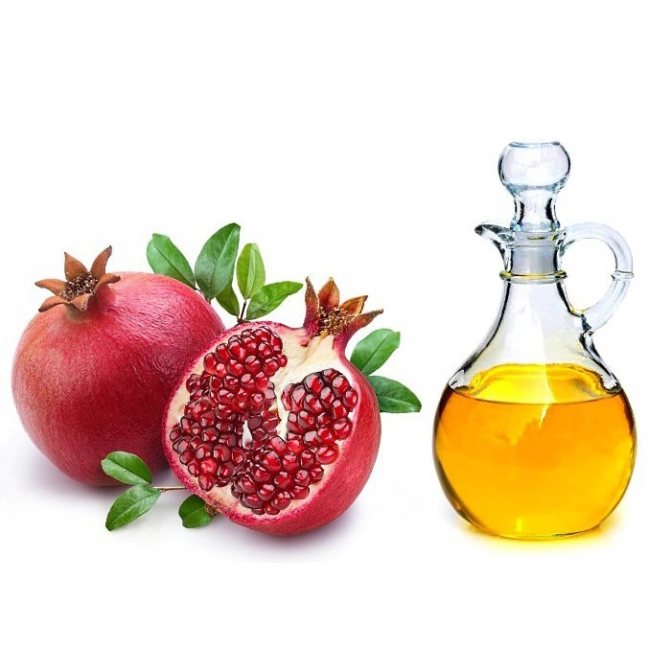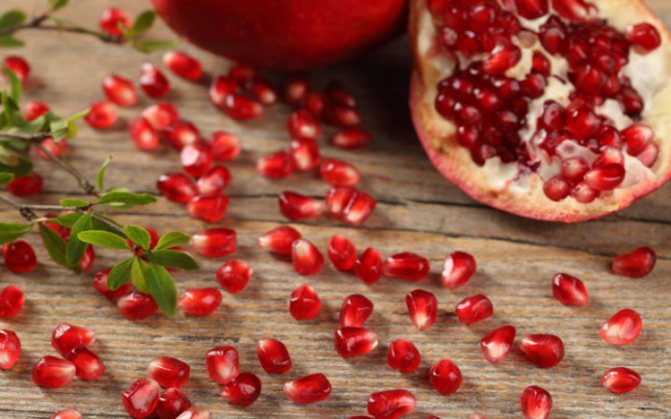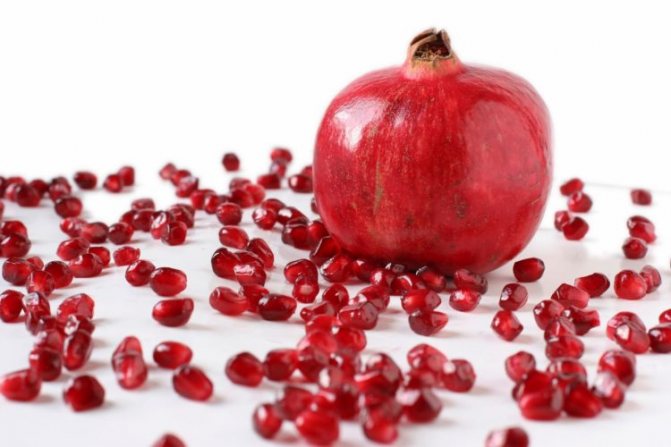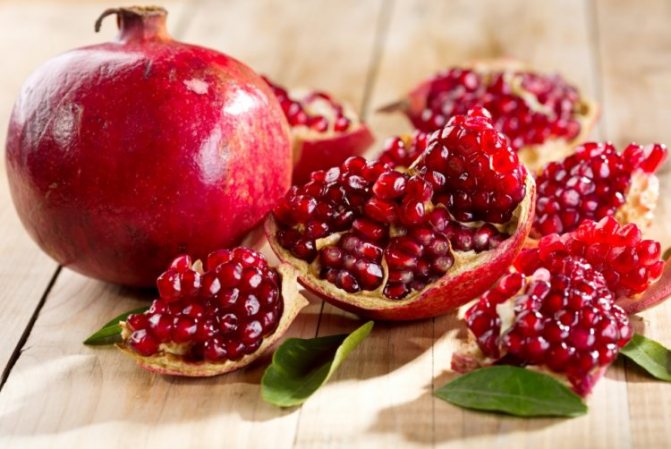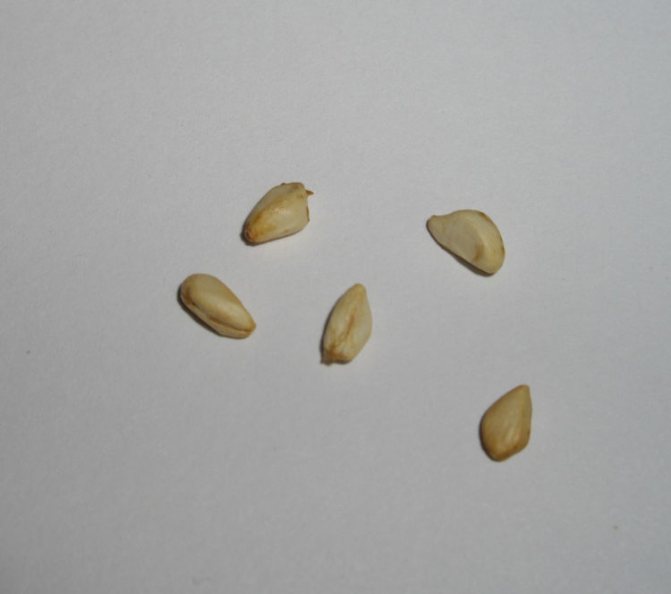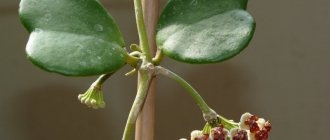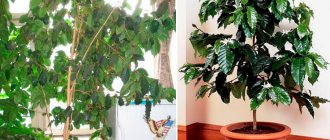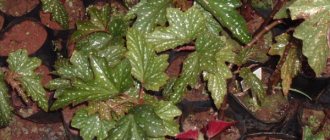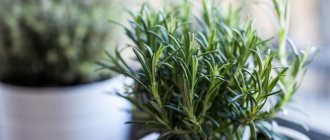Pomegranate (Punica) is widely known as a southern fruit with delicious ruby kernels. However, the tree itself, which resembles a lush shrub, has decorative value.
In outdoor conditions, the plant reaches 10 m. In indoor floriculture, the form of dwarf pomegranate (or Punica nana) is popular. It is a natural variety of “common” pomegranate. The pot is very limited in growth, and the tree barely reaches a meter in height.
Caring for a indoor pomegranate at home is quite simple, but it has its own characteristics. Although the homeland of the plant is the East, the fruit of the tree received its name when, in the X century BC. Phoenicians (for the Romans - Punyans) moved from Asia to Africa.
In Carthage (modern Tunisia), the pomegranate took root remarkably, and the Romans called it malum punicum (Punic, or Carthaginian apple), or malum granatum (granular apple). In 1758 K. Linnaeus gave the plant a botanical name - Punica. Today, the pomegranate tree is cultivated as a fruit or ornamental crop around the world.
Preparing for landing
Seed material can be purchased at a florist shop. Several popular types of decorative pomegranate have the common name Punica granatum "nana" (or dwarf), the size varies from 30 to 100 cm. Nana-pomegranate requires fairly simple home care. Popular varieties:
- "Carthage dwarf" pomegranate can grow up to a meter;
- baby pomegranate is very miniature - 30-50 cm.
There are other, less popular indoor varieties, but they are larger and are not considered dwarf.
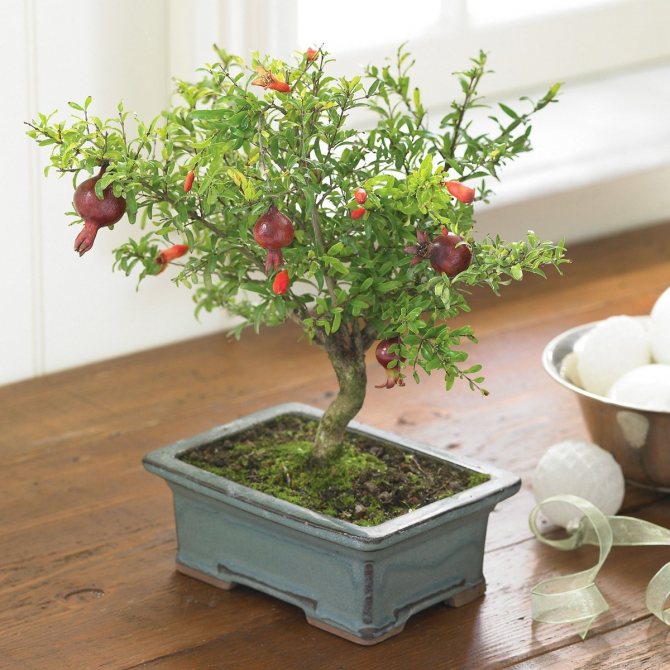
Photo:
The first description of a dwarf pomegranate was received in 1803. The height in natural conditions reaches 120 cm, in a pot - no higher than 90-100 cm. Its leaves are glossy, oval, grow in pairs. Since spring, the crown is bright green, by the end of summer it is reddish, in autumn it turns yellow. During the flowering period, it is strewn with bright red flowers. The branches are thin, fragile, erect. How to grow a beautiful and healthy pomegranate on a windowsill?
Choosing a place at home
It is best to place a pot with a home pomegranate plant right on the windowsill. The south, east or west side of the house will work, provided there is enough light. In cloudy weather, illumination with phytolamps is very desirable.
Soil selection
Wild pomegranates are often content with poor and dry land. But for full growth, the indoor version needs to create good conditions. Pomegranate soil loves neutral, loose, nutritious, with drainage (expanded clay, pebbles are suitable). You can prepare the soil for the indoor pomegranate yourself. Usually it is sod and leafy land, humus, sand in approximately the same proportions. You can also add peat, but remember about the neutral reaction! Purchased soil can be selected suitable for roses or begonias.
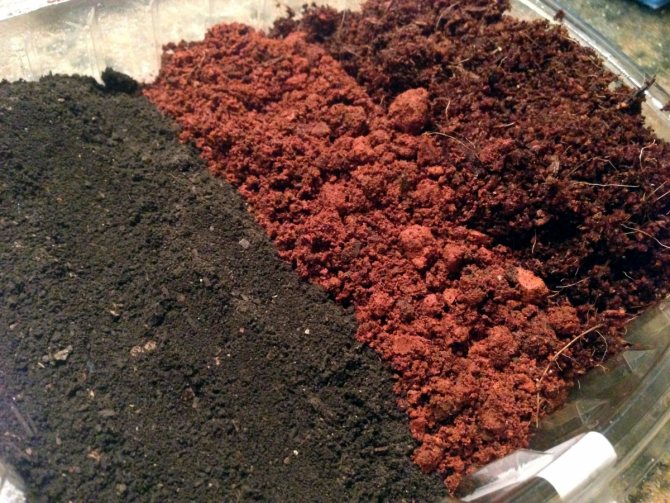

Photo:
Pot selection
The root system of a pomegranate grows stronger in width than in depth, like a loofah. The pot should be wide and shallow so that the roots take up the entire volume of the earth. Therefore, large sizes are not required.
How to eat pomegranate with seeds correctly
When choosing a pomegranate, you should pay attention to the appearance of its peel. It should be smooth and tight. The presence of cracks and damage indicates that the fruit is overripe.The rind has a deep red color. The weight of a ripe pomegranate is heavier.
Before cutting, you need to remove the inflorescences and rinse the peel under running water. To divide the fruit into slices, it is enough to make small cuts on the surface, and then press on it. Pomegranates can be eaten one at a time or several at a time.
Planting seeds
Propagation by seeds (seeds) from purchased fruits is not recommended, since these fruits are often hybrid, which means they do not carry the genes of the mother plant. But you can use the fruits ripened on indoor bushes. The ripest and largest are selected. Pits suitable for sowing must be firm and creamy. Soft and greenish will not germinate. The pulp should be peeled off (otherwise it will rot during germination), the seeds should be washed, they can be kept in a weak solution of potassium permanganate and dried. Now they can be stored for up to six months. Fruits suitable for harvesting seeds ripen for winter. But the best time for any crops is spring, and the pomegranate will sprout quickly enough. At other times of the year, the process can take several months.
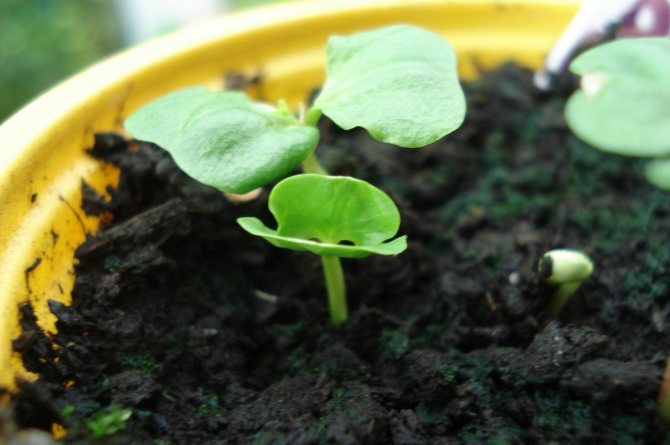

Photo: <>
Having figured out all the preparatory stages, you need to learn how to care for a room pomegranate.
Is it possible to eat pomegranate bones
The use of pomegranate seeds along with the pulp is not prohibited. The adult stomach is able to digest them completely. Moreover, it is even good for your health. Grains contain a huge amount of vitamins and minerals necessary for the body to work. For medicinal purposes, they are taken to alleviate diabetes mellitus and improve the functioning of the circulatory system. Pomegranate seeds are often used to treat diseases of the gastrointestinal tract and strengthen immunity.
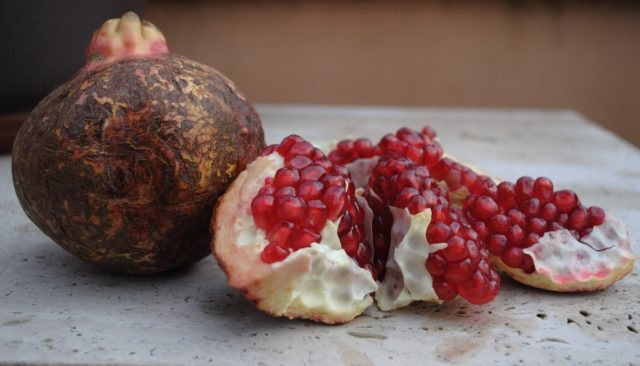

50% of the edible portion of the fruit is juice
Comment! You can eat at least 50 g of pomegranate seeds per day.
Care
The content of the pomegranate tree is quite unpretentious and simple. Caring for a indoor pomegranate at home will not be a hassle.
Lighting
This is one of the main factors for successful cultivation. Pomegranate loves a lot of sun and just bright light. Chronic lack of illumination will provoke the shedding of leaves. Strong and healthy plants can easily tolerate hot sunlight. In the summer, it is advisable to take the pot with the plant outside, since the plant also loves fresh air. But the first days in direct sunlight will not be kept for long, adaptation is needed.
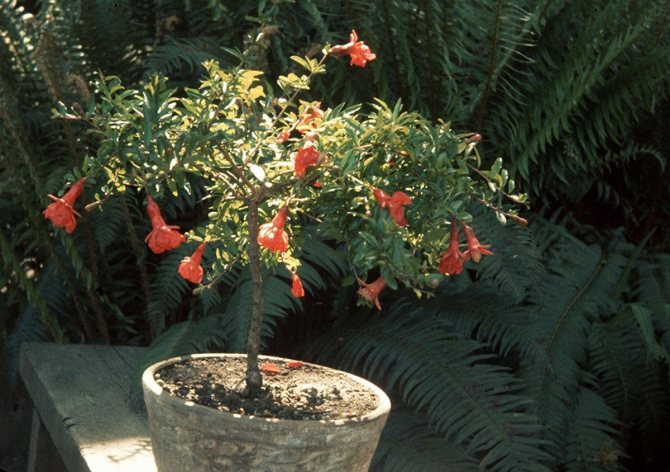

Photo:
From a lack of light, the branches of a pomegranate tree will begin to stretch, the foliage will become smaller and thinner. Caring for a home pomegranate primarily requires good lighting.
Temperature
During the growing season, that is, from spring to autumn, the optimum is 24-26 degrees, but it easily tolerates periods with higher temperatures. During the rest period, 10-12 degrees are maintained, but not lower than +7. The plant should rest for 1-2 months, this will have a beneficial effect on subsequent flowering and fruiting. If it is not possible to withstand a low temperature, then it is advisable to at least reduce watering, remove it in a dark place and remove the foliage (it will crumble itself under such conditions). But a room pomegranate may well do without a dormant period.
Watering and spraying
During the period of growth and flowering, pomegranates consume a lot of water. Water it abundantly twice a week (or as the potted soil dries up). But you can't fill it either - the plant will start to hurt. In winter, when the tree is resting, the soil must not completely dry out.
Advice: “If the pomegranate is watered abundantly after it has bloomed, then the next year the flowering will be even more magnificent. But in this case, the fruits are prone to cracking. "
He loves spraying pomegranates, so they need to be done at least once a day in the heat and a couple of times a week in warm weather.It is believed that there is no particular need for this, but the appearance of the grenade is improved. Spraying is not required in winter.
Fertilizer
Top dressing is done twice a month during the warm season. Since spring, pomegranate requires more nitrogen, during flowering - phosphorus, and with the arrival of autumn - potassium. Once a month, it is necessary to apply a complex mineral fertilizer. In autumn, fertilizing plants decrease, from December they stop completely.
Air humidity
It doesn't really matter and depends on the season. In the heat, the plant will favorably accept spraying, but other additional measures to increase humidity can be avoided.
Pruning
It will help to form a bush, stimulate it to active growth and generally have a beneficial effect on the tree. If the procedure is carried out regularly, then the plant will bush well. Pomegranate is formed into 4-6 main branches. Thin branches are pruned like this: each shoot is left with 5-6 whorls for leaves, and a neat cut is made above the top of the buds. You should not get carried away either - a large loss of the crown will weaken the plant. In addition, only annual shoots bloom, and only young shoots are cut off in the summer. This treatment stimulates flowering.
Advice: “On the pomegranate tree, fattening branches can form, that is, they do not give flowers and fruits, useless. It is better to cut them off right away, then the plant will begin to grow new shoots faster. "
Bush formation
A beautiful healthy tree consists of a main trunk, 5-6 large skeletal branches and many shoots. When grown in a pot, pomegranate often gives rise to root shoots - it must be cut off so that the main plant does not grind. Formation begins at a young age using a method such as pinching shoots. This is done after the appearance of the third pair of leaves on each shoot, simply pinching off the growth point. Thus, growing and caring for a houseplant such as pomegranate is not difficult.
Pomegranate seed composition
Pomegranate seeds are in demand due to their chemical composition. There are even more minerals in them than in the pulp. Thanks to enzymes and fiber, the correct functioning of the gastrointestinal tract is ensured. It does this by improving peristatics.
The bones contain the following components:
- fatty acid;
- vitamins of groups B, E and A;
- calcium;
- phytohormones;
- iron;
- tannins;
- phosphorus compounds;
- zinc;
- nitrogen;
- starch;
- a nicotinic acid;
- calcium;
- potassium.
Vitamins in pomegranate seeds
The use of pomegranate seeds is especially important with low immunity. This is due to the rich composition of the product. Replenishment of vitamin A reserves allows you to control oxidative and health-improving processes. In addition, it has a positive effect on visual acuity. Vitamin B is involved in the creation of red blood cells, which affects blood pressure. Vitamin E has antioxidant properties that help eliminate toxins.
Bloom
In the natural environment, it can last all year round. Pollination is independent. But indoor pomegranate specimens bloom profusely and for a long time. This usually happens from April - May to August. The large bell-shaped flowers are so beautiful that it is worth growing an exotic tree just for their sake. The flowers of the pomegranate are self-pollinated, they are divided into two types:
- jug-like, with 2 pistils, of which fruits are later set;
- bell-shaped, not bearing fruit.
There are about 10 times more empty flowers, they quickly fade and crumble. Pollinated can be fragrant for up to 10 days. Their size is 2-3 cm in diameter and 4 in length.
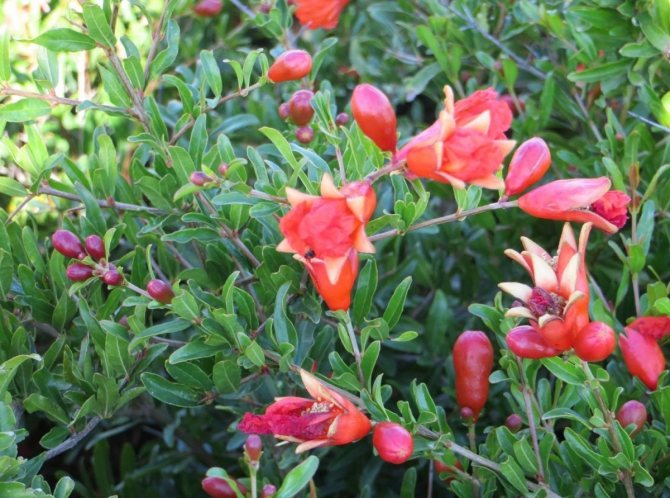

Photo:
Photo
Take a look at the photo of what pomegranate seeds and grains look like:
Dormant period
If any form of garden pomegranate grows as a room in a tub, then the tree will hibernate for the winter.In the fall, it will shed its leaves, and by the spring it will begin to release new ones. The dormant period lasts more often from November to February.
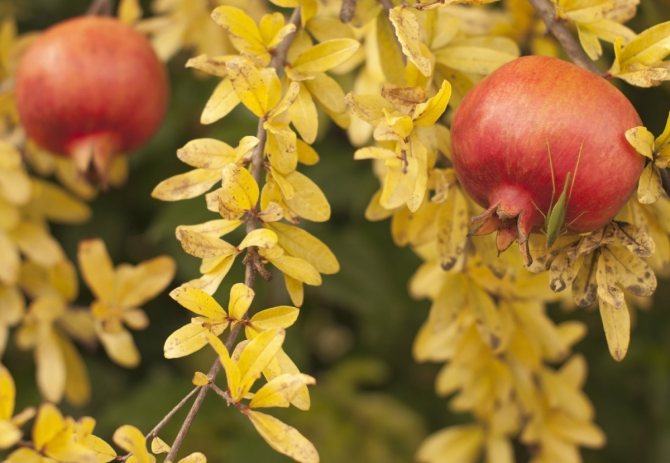

Photo:
If ordinary types of pomegranate are deciduous, then dwarf ones are evergreen. It is possible to provide the plant with additional lighting with phytolamps (so that a total daylight hours lasts 12 hours). Then there will be no rest period, but the pomegranate does not bloom at this time. If, nevertheless, the tree crumbled, then it must be placed in a cool place (veranda, loggia, even a basement), not watered or fertilized.
Who are pomegranate seeds harmful to?
When consumed in moderation, pomegranate seeds are not harmful to health. The likelihood of appendicitis depends on how thoroughly you chew them. Too much can cause stool problems. Long-term chewing increases the risk of tooth enamel damage.
The absolute contraindications for pomegranate seeds include:
- hypotension;
- hemorrhoids;
- chronic diseases of the gastrointestinal tract;
- an allergic reaction;
- a tendency to constipation;
- inflammatory processes in the oral cavity.
Reproduction
The pomegranate tree propagates easily in several ways:
Seeds (seeds)
How to grow a tree from a seed? In March or April, they are sown in a container with loose soil under a film. Before planting pomegranates, it is better to soak the seeds in a growth stimulant solution for 12 hours. To do this, they are wrapped in damp gauze and covered with a film so that not only moisture but also air can be accessed. You can just put the bones in a saucer and pour in the liquid so that they are partially in the air. Such measures will speed up seedlings. Growing a pomegranate indoor plant is made from fresh seeds, because they quickly lose their germination. They are deepened by 1 cm. They germinate within 2 weeks. For germination, you need light, heat 25-27 degrees, moist soil (you can save it from drying out by periodic spraying so as not to accidentally wash out the soil). The pick is made in the phase of 2-3 pairs of true leaves in separate small pots. When the pomegranate reaches 10-15 cm, you can start pinching the shoots so that they bush better.
Vaccination
The method is a little time consuming, but effective. As a stock, you can take any young pomegranate tree, for example, obtained from a stone. But cuttings are used varietal, from a good, healthy, flowering and fruiting tree. The grafting method can be used by any of the known methods, for example in splitting or side-notching. The guarantee of survival is not absolute, but the chances are great.
Cuttings
This method of reproduction is optimal, since the cuttings of the plant easily take root and take root, and all the genetic properties of the variety are preserved. For this, branches with 4-5 living buds are cut from the bush. The cuttings should be young, but already start to grow stiff. In spring and summer, rooting of small plants is faster. The cut twigs are soaked in root growth promoters. The lower part is cleared of buds and stuck into the soil, slightly at an angle, 3-4 cm deep. Rooting is not a quick process, some of the cuttings will dry out, so it is better to plant several of them at once. As soon as the plants take root, new shoots will start up, you can plant each pomegranate in a separate pot.
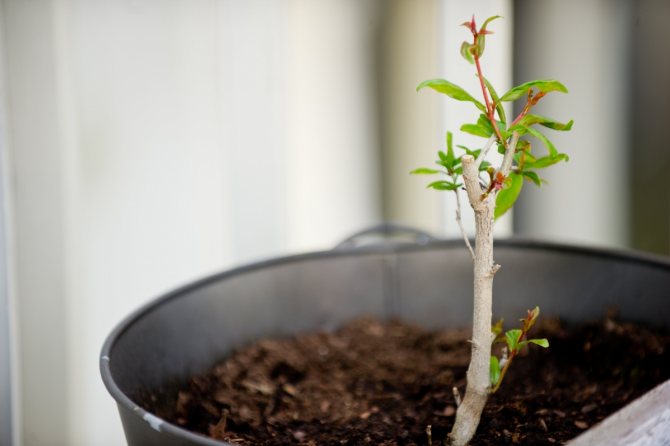

Photo:
How to eat pomegranate: with or without a bone
Whether to eat pomegranate with a bone depends on the person's desire. If the main goal is to regulate pressure or hormonal levels, then you do not need to spit out the grains. Unlike sunflower seeds, pomegranate seeds rarely cause inflammation of the appendix. The exception is the cases of their excessive use. It is not recommended to give to children. They can injure the delicate mucous membrane of the digestive system.
Is it possible to eat pomegranate with seeds for men
The beneficial effects of pomegranate seeds are most pronounced in relation to men's health.When used in moderation, they have a positive effect on potency and strengthen the muscle corset. There are no prohibitions on the absorption of seeds. Due to the presence of zinc in the composition, the process of semen production improves and libido increases.
The beneficial properties of pomegranate seeds for men also include:
- prolongation of erection by improving blood circulation;
- elimination of inflammatory processes in the small pelvis;
- stimulation of the production of sex hormones;
- increased physical endurance.
Is it possible for women to eat pomegranate seeds
The rich content of vitamins allows the use of pomegranate seeds in order to preserve youth. In addition, the healing grains have a positive effect on reproductive function. The phytohormones in the composition help to transfer the beginning of the climacteric period without complications and reduce the intensity of its manifestation. Pomegranate seeds are just as effective for premenstrual symptoms. They balance the emotional state and relieve abdominal pain. For these purposes, the product is used in the form of an alcoholic tincture.
Pomegranate seeds are indicated for women in the following cases:
- deterioration of hair condition;
- the development of thrush against the background of a decrease in immunity;
- high risk of malignant tumors in the mammary glands;
- menstrual irregularities;
- decreased sex drive.
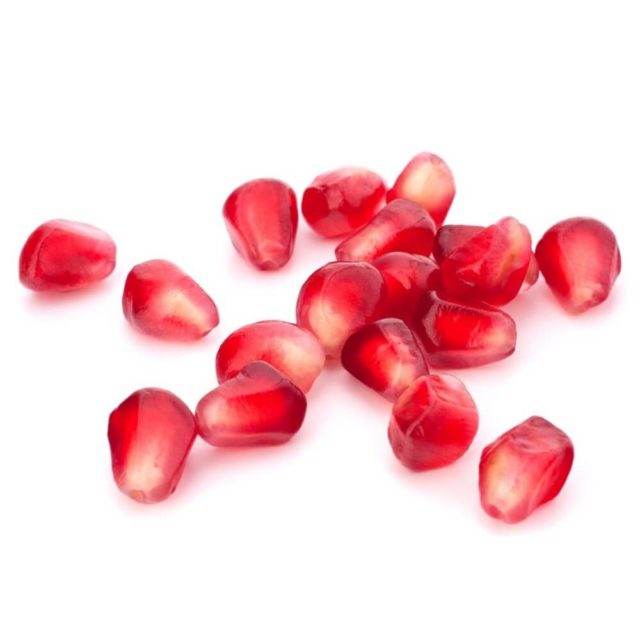

Chew the grains thoroughly to avoid problems.
During pregnancy
Women in position often use pomegranate seeds to eliminate heartburn and symptoms of toxicosis. They do not have a negative impact on the health of the unborn child. In addition, they contain a lot of vitamins and minerals that have a positive effect on the development of the baby in the womb. It is extremely important not to overuse the product, as it can provoke an allergic reaction. It is also advisable to limit its use with a tendency to lower blood pressure.
For nursing mothers
Experts recommend introducing pomegranate seeds into the diet of a nursing woman no earlier than three months after childbirth. At the first try, you can eat no more than 4-5 grains. After that, it is necessary to observe the child's reaction. If there is no suspicion of allergy, you can eat the product.
Is it possible to eat pomegranate with seeds for children
Children can eat pomegranate with seeds, but it is undesirable. A few grains eaten will not have a harmful effect. But with abuse, the risk of damage to the mucous membrane of the digestive system increases. The most suitable alternative for children is pomegranate juice. It is strictly forbidden to give pomegranates to a child under the age of three.
Diseases
Unfavorable conditions, such as high humidity, low temperatures, lack of fresh air, can provoke plant diseases such as:
Powdery mildew starts up from dampness, the fungus that covers the leaves of the tree with a white coating spreads through the plant at a tremendous speed. At the initial stage, spraying with ash or soap solution, colloidal sulfur will help, but if it does not help, then only with chemicals.
Spots on the leaves talk about the presence of parasites or diseases, the plant must be examined immediately.
Branch cancer - an intractable disease caused by a fungus or bacteria. Branches begin to dry on the tree, bark deteriorates. The affected parts should be removed immediately (with a margin of 2 cm from the healthy part), and the sections and the whole tree should be treated with copper-containing preparations. If the main trunk is affected, then it will not be possible to save the plant. When the leaves of a plant fall off before the onset of winter, this is the norm.
If leaf fall began in the middle of the growing season, then, probably, watering is insufficient, or there is a lack of nutrients, a stuffy room, too rare spraying in the heat.Growth retardation can be caused by transplanting into an oversized pot.
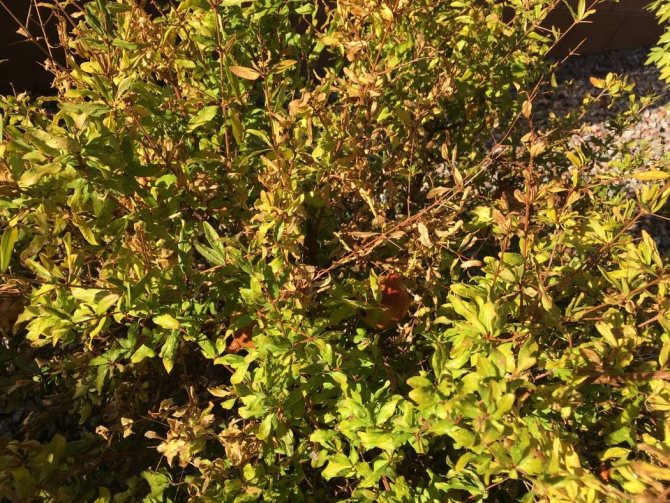

Photo:
Excess moisture will cause the leaves to turn yellow. With systematic flooding, the underground part of the tree will begin to rot. Then the pomegranate must be removed from the pot, carefully examine the roots, remove the damaged ones, process the entire root system with potassium permanganate. Sprinkle the sections with ash or activated carbon, and then plant the plant in fresh soil. When transplanting, it is impossible to forget about the lower drainage layer in order to avoid relapse.
Application in cosmetology
Pomegranate seeds are successfully used not only for health problems. They have found their application in cosmetology as well.
Face Oil Blend
To get rid of wrinkles, moisturize and nourish the skin, use a mixture of pomegranate and grape seed oils.


A mask with pomegranate seed oil will help improve the appearance of facial skin
The oils are taken in equal proportions - usually 4-5 drops, mixed and applied to the face about an hour before bedtime. You need to wait until the composition is absorbed. After that, you should not wash your face, just wipe your face with a cotton pad, thus removing the remnants of the product. This oil mask should be used until the desired effect is achieved.
Hair masks
Pomegranate seeds are widely used for hair beauty.
Anti hair loss mask
To strengthen hair follicles, prevent and stop hair loss, you can prepare a mask with your own hands. This will require:
- pomegranate oil - 20 ml;
- burdock oil - 20 ml;
- aloe juice - 50 ml;
- yogurt - 3 tbsp. l.


For the best effect, after applying the mask, you need to put a shower cap on your head and wrap it with a towel
Mix all the ingredients and apply to hair, then put on a bathing cap and wrap a towel around your head. After an hour, the product must be washed off with shampoo and rinsed with water at room temperature.
The mask moisturizes hair, roots, nourishes them and makes them stronger.
Hair strengthening mask
To strengthen hair, restore shine and strength, a mask is used with the following ingredients:
- 1 tsp corn starch;
- 1 tsp glycerin;
- 1 tsp linseed oil;
- 10 drops of vitamin D;
- half a pomegranate.


After the pomegranate mask, the hair will shine with beauty and health.
Preparation:
- Pass half of the fruit through a blender, whole with the skin and bones.
- Add the remaining components to the crushed mass.
Using:
- Apply the mask to your hair.
- Put a shower cap on your head and warm with a towel.
- Rinse hair after 40 minutes.
Mask for colored hair
To prepare a mask for colored hair, you need pomegranate seed oil and castor oil in equal quantities (40 ml each).
Preparation:
- The ingredients must be mixed.
- Heat the composition in a water bath.


Pomegranate seed oil and castor oil will help preserve the color and beauty of colored hair
Application:
- Apply a warm composition to each strand of hair and scalp.
- Put on a warm cap for an hour.
- After an hour, wash off the mask with shampoo.
- Rinse your head with warm water.
It is a very good nourishing agent for hair restoration after coloring, especially if it has become dry and dull.
Beneficial features
All varieties of pomegranate are valuable raw materials in folk medicine, almost all parts, including roots, bark and partitions in fruits, are used. Eating the "pomegranates" themselves helps to normalize blood pressure and relieve headaches, at the same time digestion problems go away, and appetite increases. In addition to fruits, dried and crushed bark of trees (as an anthelmintic or a remedy for loose stools), and leaves for making tea are also used.
Necessary conditions for growth
To know how to grow pomegranates, you need to familiarize yourself with some of the rules for indoor floriculture.
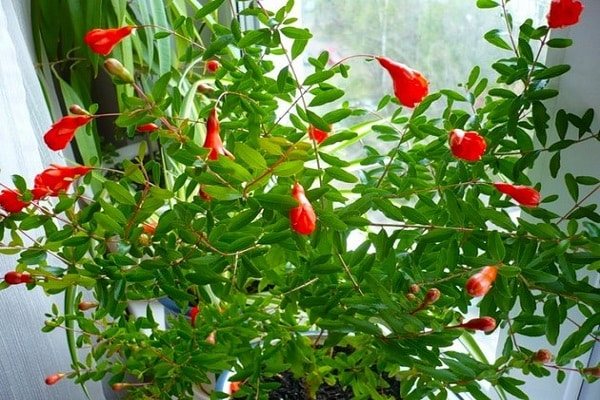

Soil composition
A young plant is suitable for soil consisting of sand, leafy, turfy land, humus. All components are taken in equal parts. For a mature tree, you can prepare a soil of 50% sod land, 25% leaf humus, 12% peat, 13% sand.
Suitable pot and its volume
Initially, the roots of the pomegranate should grow in close quarters. When transplanting, the diameter of the pot increases by 2 centimeters.
Lighting
The tree needs a lot of sunlight. It is better to place the pomegranate on the south side of the window. In the summer, at lunchtime, in order to protect the plant from burns, it must be shaded.
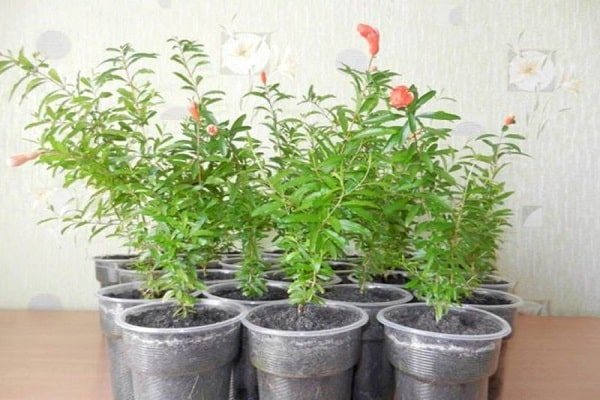

Temperature
The pomegranate tree loves warmth. During flowering, the temperature should not exceed twenty-five degrees.
Air humidity
If the room is stuffy, and the air temperature exceeds 25 degrees, the pomegranate is sprayed twice a day with summer, settled water.
Fertilizers and feeding
I am often asked what to feed the indoor pomegranate with? It is best to carry out top dressing at intervals of 2-3 weeks, and divide into 3 periods: in the spring we apply nitrogen fertilizers and achieve active growth, in the summer we gradually switch to phosphate fertilizers, the use of which will contribute to flowering, and in autumn, for the ripening of fruits and stock we feed energy for the winter with potassium compounds. We prepare fertilizers and apply them to the soil according to the instructions on the packages.
Tip 4. When applying nitrogen fertilizers, wrap the plant trunks with polyethylene so that the solution does not fall on the plant itself, otherwise burns may appear on its surface.
Separately about fruits
The fruits themselves, by the way, can be painted in a variety of colors: from orange to brownish red. Alas, but they are far from the "ordinary" pomegranate in taste, and in diameter they are a maximum of six to seven centimeters. You can taste them starting in November. The fruiting season ends around January. Since pomegranates are most often grown at home for flowers, the fruits are usually removed. This is due to the fact that the abundant flowering already greatly depletes the plant, so in order to preserve the decorative properties of the pomegranate, it is better to remove the emerging ovaries. However, one or two fruits can still be left on one tree. And it is worth doing this not so much for the sake of culinary purposes, but to get your own seeds. Note, however, that the varietal qualities of plants can not always indulge with this method of reproduction. And only once every three to four years can you make yourself a gift, leaving all the fruits on the tree. The beauty of a blooming and fruiting pomegranate at the same time is simply indescribable.
Description of the plant
Pomegranate (from Lat. Punicia) in the wild is mainly a tree of short stature, about 2-5 meters in height. A little less often there is a shrub, the fruits of which are as large as those of trees, but give off sourness, which gives a special piquancy to the taste of the fruit. Due to its unpretentiousness, the plant is distributed over a wide range of latitudes, and grows mainly on two continents: Eurasia and Africa. In various sources, there is information about the origin of pomegranate in northern Africa, western Asia and southern Europe, one thing is clear for sure - this type of fruit appeared independently and quite a long time ago, and domestication does not have a specific historical place of origin. I cannot but tell about the history of the origin of the name Pomegranate itself: from Latin punicus it is translated as Carthaginian or Punic. The Punyans (now their state is called Tunisia) supplied the most delicious pomegranates to Rome. Since then, the name has "stuck" to the heroes of this article. There are also two more names for this fruit, which were popular among the people: malum granatum and malum punicum (malum from Latin "apple"). Indeed, the similarities are obvious. In ancient Greek culture, pomegranate takes its rightful place, personifying and symbolizing a happy marriage, love full of passion, and fertility.
Pruning procedure
Around February, the pomegranates are taken out of the cold room and, while the buds have not yet blossomed, pruning is carried out. The plant tolerates this pruning procedure best of all. Most of all small young twigs should be removed. To stimulate branching, it is necessary to prune the branches outside the bud at an acute angle, leaving no more than five internodes on the shoot. Important! When shaping your indoor pomegranate, never forget to leave within the six skeletal branches that form the base of the entire plant. If you get carried away with pruning, you can significantly weaken the tree. By the way, it is for the formation of the woody form of pomegranate (including bonsai) that you need to mercilessly remove all the young growth in the pot. When forming branches and pruning, you need to be extremely careful, since the shoots are fragile. Excess shoots formed during the current growing season can also be removed in summer. In this case, it is advisable to close the wound with garden pitch.
Complications
Sometimes people are afraid that pomegranate seeds can cause appendicitis. There can be several reasons for the development of this disease. One of them is the ingress of a foreign body into the appendix. Appendicitis can occur if pomegranate seeds penetrate the appendix and block its passage. However, they are composed mainly of fiber, which is partially digested by enzymes in the stomach. With good chewing, the bones are crushed and, getting into the digestive tract, they help to clean it, acting like a brush. The most common cause of appendicitis is infection with pathogens. The bones do not contain bacteria that would cause inflammation. In addition, the grain size is too small to cover the opening of the appendix.
If the bone is stuck in your throat, do not panic. To get rid of it, you can use simple methods. For example, you can put wax or paraffin on the tip of your finger, then feel for a bone and try to glue it. Allow to harden and remove. Another way: eat a piece of stale bread, which in the process of swallowing will carry the grain along.


